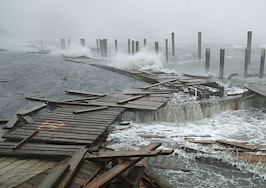Whether it’s a hurricane like Dorian or a tropical storm, flood, tornado, earthquake or fire, it can take years to resolve a major insurance claim and restore a property.
In 1994, I sustained over $100,000 of damage to my house from the Northridge earthquake. My insurance company gave me the run around for three years until I hired a public insurance adjuster who finally got them to settle.
If you’re wondering what public insurance adjusters do, Scott Friedson, a public insurance adjuster (PA) and the CEO of Insurance Claim Recovery Support described it like this:
Like your CPA who attends your IRS audit on your behalf, a good PA will be your advocate with the insurance company and will negotiate on your behalf to settle your insurance claim.
A study by the Florida Legislature showed that those who worked with a PA to settle their claims received higher settlements than those who did not.
If you or your clients have sustained a major loss (or if you sustain a major loss in the future) from a natural disaster like last year’s hurricane Florence or the current hurricane Dorian, here’s what Friedson recommends you do:
1. Be mindful of the risks
In places like Houston, New Orleans and Florida, it only takes three to five days for serious mold problems to develop. If your property has been flooded or has sustained any other type of major water damage, you will need a respirator and a face mask to safely enter the property.
Flood waters carry serious bacteria and viruses that can endanger your life, and there’s also the risk of being electrocuted by downed power lines that are not visible. As much as you may want to go home, avoid moving back in until after any mold, asbestos or other toxic substances have been removed.
Your safety and health come first.
2. Immediately notify the insurance company that you have a claim
By filing your claim right away, you are more likely to settle your claim quickly and find a local, high-quality contractor. The sooner your claim is settled, the faster you can get your life back to normal.
To file your claim, contact your local agent, call the special 800 number the company sets up, log into your online account or visit a mobile claims center.
Flood insurance is separate from your homeowner’s policy and is issued through the National Flood Insurance Program (NFIP). If you have purchased flood insurance, your insurance agent will generally assist you in beginning the filing process.
Unfortunately, if your home was flooded and you did not purchase flood insurance through the National Flood Insurance Program (NFIP), you have no coverage. Nevertheless, there may be government assistance programs available. Visit DisasterAssistance.gov and FloodSmart.gov for more information.
The good news is that if you purchased “comprehensive” coverage on your vehicle insurance and your vehicles sustained flood damage, they should be covered.
3. Establish the pre-loss and post-loss condition of your property
Ideally, you have already taken pictures and videos of every aspect of your home (especially the roof) as a routine part of keeping your home insurance up-to-date.
If you haven’t taken pictures or videos of your home in the past, take them now and update them annually. The reason? If you change insurance carriers and have a claim, it’s common for your current insurance carrier to argue that your damage happened before the policy became active. Having a set of annual photos or videos provides documentation to support which insurance company is responsible for handling the claim.
If your home is damaged and you don’t have videos or photos, you can verify its pre-loss condition using holiday photos, MLS photos (if your property has been listed), an inspection report or even a recent appraisal. If you have receipts for your furniture, appliances, and any other work you have done, those are also useful.
After you have documented the condition of the property with photos and videos, Friedson advises that you start the cleanup, but do not make any repairs. Doing so constitutes “spoilage of evidence.” The insurance company has the right to investigate the loss. Move furniture away from walls or other places where there is damage to make viewing it easier.
4. Your policy requires you to mitigate damages
To “mitigate damages” means taking steps to prevent any further damage. For example, if there’s a hole in the roof, you must have the roof tarped until you can have it repaired. In the case where there is substantial water damage, contact a water damage specialist to remove the wet sheetrock, insulation, drywall, carpets, flooring, etc. Please note that with severe flooding, the water may seep up the walls and even across the ceiling.
If you own an older home, there may be asbestos in the flooring, inside the walls, and near stoves, fireplaces and heaters. Asbestos removal is highly regulated due to the health issues it poses. Only hire people who are experienced experts in this area. Improper removal, whether it’s mold or asbestos, can cause serious illness and result in even more expensive remediation.
The good news is that most states require insurers to reimburse mitigation expenses within 30 days.
5. What are the provisions for ‘loss of use’ and ‘displacement’ in your policy?
If your home has major damage, you may be unable to live there while it is being repaired. Most insurance policies provide for living expenses, but these seldom last beyond one year. This often means the homeowner is in a race to finish repairs before living expense money runs out. Again, if you didn’t purchase flood insurance, you’re not covered for flood-related living expenses.
When it comes time to hire a contractor, Friedson recommends only working with vetted local contractors who are willing to warrant their work. If you hire one of the transient contractors that show up after major disasters and there’s an issue with their work, you have little or no recourse when they leave the area.
6. Examine your policy: Do you have ‘cash’ or ‘replacement value’?
Regardless of whether your home is damaged or not, check your current insurance policy to determine if you have “cash” or “replacement” value when you have a claim. A “cash value” policy only pays on the depreciated value of your property. A “replacement value” policy provides you with the full cost of replacement and is definitely the best choice. If you don’t have replacement value coverage, it’s smart to add it now and here’s why:
If you have a 20-year roof that is five years old and you have a “cash value” policy, your roof would have depreciated 25 percent. If you had to replace the roof, you would only receive 75 percent of the replacement cost less the deductible. If you have “replacement value,” the deductible is your only cost.
Also, any settlement check you receive will be made out to you and to your mortgage lender. The lender will visit the property to verify that the work has been completed before they countersign the check.
7. Avoid lawsuits
If you file a lawsuit, your attorney will be working on a contingency basis while the insurance company attorneys bill hourly. In other words, the insurance attorneys have no incentive to settle because the longer they drag out the process, the more money they make.
Their goal is to wear you down with depositions, examinations of your financials and constant delays. The bottom line: go the PA route first and only litigate when there is no other option.
8. Cost of hiring a PA
State regulations determine the fees PAs can charge. In most states, the maximum is ten percent of the entire claim. If the homeowner has been partially reimbursed before hiring the PA, the PA can charge a higher percentage of the remaining balance, but it can never exceed ten percent of the total claim.
9. Avoid bad apples
As in any profession, there are good and bad apples. To avoid hiring the wrong PA, here’s what to do:
- Ask the PA whether he or she ever does work for an insurance company. If the answer is yes, hire someone else who doesn’t have a conflict of interest.
- Interview at least three PAs and ask for references.
- Ask the PA how long the process takes.
- Ask what is the average length of his or her files (number of pages). Some PAs do little or nothing because they’re setting the homeowner up to be referred to an attorney.
- Also, inquire about what percentage of his or her cases are settled versus what percentage go to litigation or appraisal (a process Friedson recommends that homeowners avoid.)
A major insurance loss means your life will be disrupted for many months to come. Friedson advises to give your insurance company a chance to do the right thing. Most companies will try their best to do so, but if it’s not happening, consider hiring a PA to get the settlement you deserve.
For more information on what it’s like to get through a disaster, listen in to my interview with Tiffany McQuaid, president of McQuaid & Company Real Estate Services, who has been through several hurricanes in Naples, Florida.
Bernice Ross, President and CEO of BrokerageUP (brokerageup.com) and RealEstateCoach.com, is a national speaker, author and trainer with over 1,000 published articles. Learn about her broker/manager training programs designed for women, by women, at BrokerageUp.com and her new agent sales training at RealEstateCoach.com/newagent.








